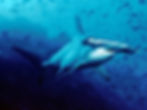The 10 Known Species of Hammerhead Sharks: A Guide by Shark Guardian
- Shark Guardian
- May 18
- 3 min read
Hammerhead sharks, with their distinctive hammer-shaped heads, are among the most recognizable and fascinating marine creatures. Comprising of ten known species across two genera—Sphyrna and Eusphyra—these sharks inhabit various marine environments worldwide. Unfortunately, many hammerhead species face significant threats due to overfishing, habitat loss, and the shark fin trade. This guide provides an overview of each species, their habitats, and conservation.
1. Great Hammerhead shark (Sphyrna mokarran)
Distribution: Found in tropical and warm temperate waters worldwide, including the Atlantic, Indian, and Pacific Oceans.
IUCN Status: Critically Endangered
The largest of the hammerhead species, the Great Hammerhead can grow up to 6 meters in length. They are solitary predators known to inhabit coastal areas and continental shelves. Their large fins make them a prime target for the shark fin trade, contributing to their declining populations.
2. Scalloped Hammerhead shark (Sphyrna lewini)
Distribution: Found worldwide in coastal warm temperate and tropical seas, including the Atlantic, Indian, and Pacific Oceans.
IUCN Status: Critically Endangered
Named for the scalloped shape of their cephalofoil, Scalloped Hammerheads are known for forming large schools during the day. They are often found near continental and insular shelves and are highly susceptible to overfishing due to their schooling behavior.

3. Smooth Hammerhead shark (Sphyrna zygaena)
Distribution: Widespread in temperate and tropical waters worldwide, including the Atlantic, Indian, and Pacific Oceans.
IUCN Status: Vulnerable
The Smooth Hammerhead lacks the central indentation found in other hammerhead species' heads. They prefer cooler waters and are often found in coastal areas. Like other hammerheads, they are threatened by bycatch and targeted fishing.

4. Bonnethead shark (Sphyrna tiburo)
Distribution: Western Atlantic Ocean, from the Carolinas to Brazil, including the Gulf of Mexico; Eastern Pacific from southern California to Ecuador.
IUCN Status: Endangered
The smallest hammerhead species, Bonnetheads are unique for their diet, which includes seagrass—making them one of the few omnivorous sharks. They inhabit shallow coastal waters and estuaries.

5. Winghead shark (Eusphyra blochii)
Distribution: Indo-West Pacific region, from the Persian Gulf to northern Australia and the Philippines.
IUCN Status: Endangered
Distinguished by its exceptionally wide head, the Winghead shark utilizes its cephalofoil to enhance sensory perception. It inhabits shallow coastal waters and is vulnerable to habitat degradation and fishing pressures.

6. Scoophead shark (Sphyrna media)
Distribution: Western Atlantic, from Panama to southern Brazil; Eastern Pacific, from the Gulf of California to Ecuador.
IUCN Status: Data Deficient
A smaller hammerhead species, the Scoophead is often confused with the scalloped hammerhead due to similar features. Limited data on its population and ecology make conservation assessments challenging.

7. Scalloped Bonnethead shark (Sphyrna corona)
Distribution: Eastern Pacific, from Mexico to Peru.
IUCN Status: Data Deficient
One of the lesser-known hammerhead species, the Scalloped Bonnethead inhabits shallow coastal waters. Its small size and limited range make it susceptible to coastal development and fishing activities.

8. Whitefin Hammerhead shark (Sphyrna couardi)
Distribution: Eastern Atlantic, from Mauritania to Angola.
IUCN Status: Data Deficient
A rare species with limited information available, the Whitefin Hammerhead is distinguished by its white-tipped fins. Its deepwater habitat and elusive nature contribute to the scarcity of data.
(NO IMAGE AVAILABLE)
9. Carolina Hammerhead shark (Sphyrna gilberti)
Distribution: Western Atlantic, primarily off the southeastern United States.
IUCN Status: Data Deficient
Described as a distinct species in 2013, the Carolina Hammerhead closely resembles the Scalloped hammerhead but has fewer vertebrae. Its recent classification means that much about its ecology and population status remains unknown.

10. Smalleye Hammerhead shark (Sphyrna tudes)
Distribution: Western Atlantic, primarily along the coasts of Venezuela, Guyana, Suriname, Brazil, and Uruguay.
IUCN Status: Critically Endangered
The Smalleye Hammerhead, also known as the Golden Hammerhead, is the smallest species of hammerhead shark. It inhabits shallow, muddy coastal waters and estuaries. Juveniles are particularly vulnerable due to their preference for inshore nursery areas. Overfishing and habitat degradation have caused dramatic declines in its population, particularly along the South American coast, where it is heavily targeted and caught as bycatch.

Hammerhead shark biology:
Hammerhead shark conservation:
Hammerhead sharks play a crucial role in marine ecosystems as apex predators. Their decline can have cascading effects on ocean health. Conservation efforts, including fishing regulations, habitat protection, and public education, are vital to ensure the survival of these unique species. Organizations like Shark Guardian are at the forefront of advocating for shark conservation worldwide.


